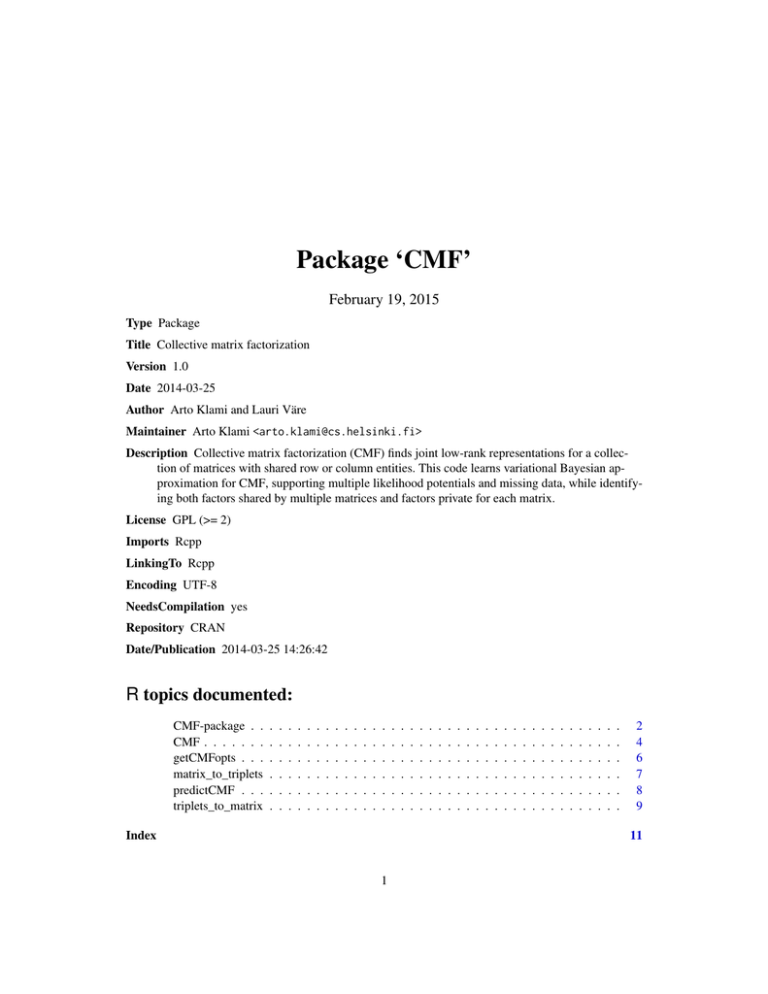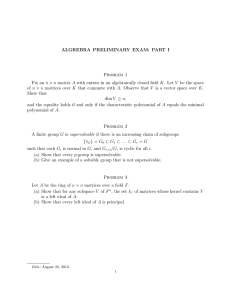Package `CMF`
advertisement

Package ‘CMF’
February 19, 2015
Type Package
Title Collective matrix factorization
Version 1.0
Date 2014-03-25
Author Arto Klami and Lauri Väre
Maintainer Arto Klami <arto.klami@cs.helsinki.fi>
Description Collective matrix factorization (CMF) finds joint low-rank representations for a collection of matrices with shared row or column entities. This code learns variational Bayesian approximation for CMF, supporting multiple likelihood potentials and missing data, while identifying both factors shared by multiple matrices and factors private for each matrix.
License GPL (>= 2)
Imports Rcpp
LinkingTo Rcpp
Encoding UTF-8
NeedsCompilation yes
Repository CRAN
Date/Publication 2014-03-25 14:26:42
R topics documented:
CMF-package . .
CMF . . . . . . .
getCMFopts . . .
matrix_to_triplets
predictCMF . . .
triplets_to_matrix
.
.
.
.
.
.
.
.
.
.
.
.
.
.
.
.
.
.
.
.
.
.
.
.
.
.
.
.
.
.
.
.
.
.
.
.
.
.
.
.
.
.
.
.
.
.
.
.
.
.
.
.
.
.
.
.
.
.
.
.
.
.
.
.
.
.
.
.
.
.
.
.
.
.
.
.
.
.
Index
.
.
.
.
.
.
.
.
.
.
.
.
.
.
.
.
.
.
.
.
.
.
.
.
.
.
.
.
.
.
.
.
.
.
.
.
.
.
.
.
.
.
.
.
.
.
.
.
.
.
.
.
.
.
.
.
.
.
.
.
.
.
.
.
.
.
.
.
.
.
.
.
.
.
.
.
.
.
.
.
.
.
.
.
.
.
.
.
.
.
.
.
.
.
.
.
.
.
.
.
.
.
.
.
.
.
.
.
.
.
.
.
.
.
.
.
.
.
.
.
.
.
.
.
.
.
.
.
.
.
.
.
.
.
.
.
.
.
.
.
.
.
.
.
.
.
.
.
.
.
2
4
6
7
8
9
11
1
2
CMF-package
CMF-package
Collective Matrix Factorization (CMF)
Description
Collective matrix factorization (CMF) finds joint low-rank representations for a collection of matrices with shared row or column entities. This package learns a variational Bayesian approximation
for CMF, supporting multiple likelihood potentials and missing data, while identifying both factors
shared by multiple matrices and factors private for each matrix.
Details
Package:
Type:
Version:
Date:
License:
CMF
Package
1.0
2014-03-25
GPL (>= 2)
The package implements variational Bayesian approximation for CMF, following the presentation
in "Group-sparse embeddings in collective matrix factorization".
The main functionality is provided by the function CMF that is used for learning the model, and by
the function predictCMF that estimates missing entries based on the learned model. These functions
take as input lists of matrices in a specific sparse format that stores only the observed entries but
that explicitly stores zeroes (unlike most sparse matrix representations). For converting between
regular matrices and this sparse format see matrix_to_triplets and triplets_to_matrix.
The package can also be used to learn Bayesian canonical correlation analysis (CCA) and group
factor analysis (GFA) models, both of which are special cases of CMF. This is likely to be useful for
people looking for CCA and GFA solutions supporting missing data and non-Gaussian likelihoods.
Author(s)
Arto Klami and Lauri Väre
Maintainer: Arto Klami <arto.klami@cs.helsinki.fi>
References
Arto Klami, Guillaume Bouchard, and Abhishek Tripathi. Group-sparse embeddings in collective
matrix factorization. arXiv:1312.5921, 2013.
Arto Klami, Seppo Virtanen, and Samuel Kaski. Bayesian canonical correlation analysis. Journal
of Machine Learning Research, 14(1):965–1003, 2013.
Seppo Virtanen, Arto Klami, Suleiman A. Khan, and Samuel Kaski. Bayesian group factor analysis.
In Proceedings of the 15th International Conference on Artificial Intelligence and Statistics, volume
22 of JMLR:W&CP, pages 1269-1277, 2012.
CMF-package
Examples
require("CMF")
# Create data for a circular setup with three matrices and three
# object sets of varying sizes.
X <- list()
D <- c(10,20,30)
inds <- matrix(0,nrow=3,ncol=2)
# Matrix 1 is between sets 1 and 2 and has continuous data
inds[1,] <- c(1,2)
X[[1]] <- matrix(rnorm(D[inds[1,1]]*D[inds[1,2]],0,1),nrow=D[inds[1,1]])
# Matrix 2 is between sets 1 and 3 and has binary data
inds[2,] <- c(1,3)
X[[2]] <- matrix(round(runif(D[inds[2,1]]*D[inds[2,2]],0,1)),nrow=D[inds[2,1]])
# Matrix 3 is between sets 2 and 3 and has count data
inds[3,] <- c(2,3)
X[[3]] <- matrix(round(runif(D[inds[3,1]]*D[inds[3,2]],0,6)),nrow=D[inds[3,1]])
# Convert the data into the right format
triplets <- list()
for(m in 1:3) triplets[[m]] <- matrix_to_triplets(X[[m]])
# Missing entries correspond to missing rows in the triple representation
# so they can be removed from training data by simply taking a subset
# of the rows.
train <- list()
test <- list()
keepForTraining <- c(100,200,300)
for(m in 1:3) {
subset <- sample(nrow(triplets[[m]]))[1:keepForTraining[m]]
train[[m]] <- triplets[[m]][subset,]
test[[m]] <- triplets[[m]][setdiff(1:nrow(triplets[[m]]),subset),]
}
# Learn the model with the correct likelihoods
K <- 4
likelihood <- c("gaussian","bernoulli","poisson")
opts <- getCMFopts()
opts$iter.max <- 10 # Less iterations for faster computation
model <- CMF(train,inds,K,likelihood,D,test=test,opts=opts)
# Check the predictions
# Note that the data created here has no low-rank structure,
# so we should not expect good accuracy.
print(test[[1]][1:3,])
print(model$out[[1]][1:3,])
# predictions for the test set using the previously learned model
out <- predictCMF(test, model)
print(out$out[[1]][1:3,])
3
4
CMF
print(out$error[[1]])
# ...this should be the same as the output provided by CMF()
print(model$out[[1]][1:3,])
CMF
Collective Matrix Factorization
Description
Learns the CMF model for a given collection of M matrices. The code learns the parameters of a
variational approximation for CMF, and also computes predictions for indices specified in test.
Usage
CMF(X, inds, K, likelihood, D, test = NULL, opts = NULL)
Arguments
X
List of input matrices.
inds
A length(X) times 2 matrix that links dimensions of the matrices in X to object
sets. inds[m, 1] tells which object set corresponds to the rows in matrix X[[m]],
and inds[m, 2] tells the same for the columns.
K
The number of factors.
opts
A list of options as given by getCMFopts(). If set to NULL, the default values
will be used.
likelihood
A list of likelihood choices, one for each matrix in X. Each entry should be a
string with possible values of: "gaussian", "bernoulli" or "poisson".
D
A vector containing sizes of each object set.
test
A list of test matrices. If not NULL, the code will compute predictions for these
elements of the matrices. This duplicates the functionality of predictCMF.
Details
The variational approximation is fully factorized over all of the model parameters, including individual elements of the projection matrices. The parameters for the projection matrices are updated
jointly by Newton-Raphson method, whereas the rest use closed-form updates.
Note that the input data needs to be given in a specific sparse format. See matrix_to_triplets
for details.
The behavior of the algorithm can be modified via the opts parameter. See getCMFopts for details.
Of particular interest are the elements useBias and method.
For full description of the output parameters, see the referred publication. The notation in the code
follows roughly the notation used in the paper.
CMF
5
Value
A list of
U
A list of the mean parameters for the rank-K projection matrices, one for each
object set.
covU
A list of the variance parameters for the rank-K projection matrices, one for each
object set.
tau
A vector of the precision parameter means.
alpha
A vector of the ARD parameter means.
cost
A vector of variational lower bound values.
inds
The input parameter inds stored for further use.
errors
A vector containing root-mean-square errors for each iteration, computed over
the elements indicated by the test parameter.
bias
A list (of lists) storing the parameters of the row and column bias terms.
D
The sizes of the object sets as given in the parameters.
K
The number of components as given in the parameters.
Uall
Matrices of U joined into one sum(D) by K matrix, for easier plotting of the
results.
items
A list containing the running number for each item among all object sets. This
corresponds to rows of the Uall matrix. Each part of the list contains a vector
that has the numbers for each particular object set.
out
If test matrices were provided, returns the reconstructed data sets. Otherwise
returns NULL.
M
The number of input matrices.
likelihood
The likelihoods of the matrices.
opts
The options used for running the code.
Author(s)
Arto Klami and Lauri Väre
References
Arto Klami, Guillaume Bouchard, and Abhishek Tripathi. Group-sparse embeddings in collective
matrix factorization. arXiv:1312.5921, 2013.
Examples
#See CMF-package for an example.
6
getCMFopts
getCMFopts
Default options for CMF
Description
A helper function that creates a list of options to be passed to CMF. To run the code with other option
values, first run this function and then directly modify the entries before passing the list to CMF.
Usage
getCMFopts()
Details
Most of the parameters are for controlling the optimization, but some will alter the model itself. In
particular, useBias is used for turning the bias terms on and off, and method will change the prior
for U.
The default choice for method is "gCMF", providing the group-wise sparse CMF that identifies both
shared and private factors (see Klami et al. (2013) for details). The value "CMF" turns off the groupwise sparsity, providing a CMF solution that attempts to learn only factors shared by all matrices.
Finally, method="GFA" implements the group factor analysis (GFA) method, by fixing the variance
of U[[1]] to one and forcing useBias=FALSE. Then U[[1]] can be interpreted as latent variables
with unit variance and zero mean, as assumed by GFA and CCA (special case of GFA with M=2).
Note that as a multi-view learning method "GFA" requires all matrices to share the same rows, the
very first entity set.
Value
Returns a list of:
init.tau
Initial value for the noise precisions. Only matters for Gaussian likelihood.
init.alpha
Initial value for the automatic relevance determination (ARD) prior precisions.
grad.reg
The regularization parameter for the under-relaxed Newton iterations. 0=no regularization, larger values provide inncreasing regularization. The value must be
below 1.
gradIter
How many gradient steps for updating the projections are performed during each
iteration of the whole algorithm. Default is one.
grad.max
Maximum absolute change for the elements of the projection matrices during
one gradient step. Small values help to prevent over-shooting, wheres inf results
to no constraints. Default is inf.
iter.max
Number of iterations for the whole algorithm.
computeCost
Should the cost function values be computed or not. Defaults to TRUE.
verbose
0 = supress all printing, 1 = print current iteration and test RMSE every now and
then, 2 = in addition to level 1 print also the current gradient norm.
matrix_to_triplets
7
useBias
Set this to FALSE to exclude the row and column bias terms. The default is
TRUE.
method
Default value of "gCMF" computes the CMF with group-sparsity. The other
possible values are "CMF" for turning off the group-sparsity prior, and "GFA"
for implementing group factor analysis (and canonical correlation analysis when
M=2).
prior.alpha_0 Hyperprior values for the gamma prior for ARD.
prior.alpha_0t
Hyperprior values for the gamma prior for tau.
Author(s)
Arto Klami and Lauri Väre
References
Arto Klami, Guillaume Bouchard, and Abhishek Tripathi. Group-sparse embeddings in collective
matrix factorization. arXiv:1312.5921, 2013.
Seppo Virtanen, Arto Klami, Suleiman A. Khan, and Samuel Kaski. Bayesian group factor analysis.
In Proceedings of the 15th International Conference on Artificial Intelligence and Statistics, volume
22 of JMLR:W&CP, pages 1269-1277, 2012.
See Also
’CMF’
Examples
CMF_options = getCMFopts()
CMF_options$iter.max = 500 #Change the number of iterations from default of 200 to 500.
CMF_options$useBias = FALSE #Don't take row and column means into consideration.
#These options will be in effect when CMF_options is passed on to CMF.
matrix_to_triplets
Conversion from matrix to coordinate/triplet format
Description
The CMF code requires inputs to be speficied in a specific sparse format. This function converts
regular R matrices into that format.
Usage
matrix_to_triplets(orig)
Arguments
orig
A matrix of class matrix
8
predictCMF
Details
The element X[i,j] on the i:th row and j:t column is represented as a triple (i,j,X[i,k]). The input for
CMF is then a matrix where each row specifies one element, and hence the representation is of size
Nx3, where N is the total number of observed entries.
In the original input matrix the missing entries should be marked as NA. In the output they will be
completely omitted.
Even though this format reminds the representation often used for representing sparse matrices, it
is important to notice that observed zeroes are retained in the representation. The elements missing
from this representation are considered unknown, not zero.
Value
The input matrix in triplet/coordinate format.
Author(s)
Arto Klami and Lauri Väre
See Also
triplets_to_matrix
Examples
x <- matrix(c(1,2,NA,NA,5,6),nrow=3)
triplet <- matrix_to_triplets(x)
print(triplet)
predictCMF
Predict with CMF
Description
Code for predicting missing elements with an existing CMF model. The predictions are made for
all of the elements specified in the list of input matrices X. The function also returns the root mean
square error (RMSE) between the predicted outputs and the values provided in X.
Usage
predictCMF(X, model)
Arguments
X
A list of sparse matrices specifying the indices for which to make the predictions. These matrices must correspond to the structure used for X when learning
the model with CMF.
model
A list of model parameter values provided by CMF.
triplets_to_matrix
9
Details
Note that X needs to be provided as a set of triplets instead of as a regular matrix. See matrix_to_triplets.
Value
A list of
out
A list of matrices corresponding to predictions for each matrix in X.
error
A vector containing the root-mean-square error for each matrix separately.
Author(s)
Arto Klami and Lauri Väre
Examples
#See CMF-package for an example.
triplets_to_matrix
Conversion from triplet/coordinate format to matrix
Description
This function is the inverse of matrix_to_triplets. It converts a matrix represented as a set of
triplets into an object of the class matrix. The missing entries (the ones not present in the triplet
representation) are filled in as NA.
Usage
triplets_to_matrix(triplets)
Arguments
triplets
A matrix in triplet/coordinate format
Details
See matrix_to_triplets for a description of the representation.
Value
The input matrix as a normal matrix of class matrix
Author(s)
Arto Klami and Lauri Väre
10
triplets_to_matrix
Examples
x <- matrix(c(1,2,NA,NA,5,6),nrow=3)
triplet <- matrix_to_triplets(x)
print(triplet)
xnew <- triplets_to_matrix(triplet)
print(xnew)
Index
∗Topic package
CMF-package, 2
CMF, 4
CMF-package, 2
getCMFopts, 6
matrix_to_triplets, 7
predictCMF, 8
triplets_to_matrix, 9
11





